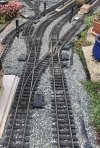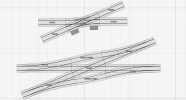playmofire
Registered
Does anyone have a video of the LGB double slip in use, please?
Thanks, I'll have a look at those.Curtis has a couple on the HBSA....
I have two different LGB double slips Gordon. Which one are you talking about - the earlier type with a long thin motor on one side or the later type with a standard point motor each end?Does anyone have a video of the LGB double slip in use, please?
The later one, Mike.I have two different LGB double slips Gordon. Which one are you talking about - the earlier type with a long thin motor on one side or the later type with a standard point motor each end?
If you don't have any joy I'll dig one out of the spare track box tomorrow and film it for you.The later one, Mike.
Thanks, Mike. I'm intrigued how it works.If you don't have any joy I'll dig one out of the spare track box tomorrow and film it for you.
When you have a moment, Mike, I'd be very grateful if you would.If you don't have any joy I'll dig one out of the spare track box tomorrow and film it for you.
Your wish is my command Gordon. Please forgive the quality as it is difficult to film with one hand and use the other to operate the slips. It's all done by my fair hand as I don't have any power units accessible ATM. The first one is the older unit which has just one motor. The later job has the two point motors. As you will see the track units are pretty much identical. The operation however is slightly different as the single motor one converts the running from straight through to crossover in one go whereas the other treats each end as a separate point.When you have a moment, Mike, I'd be very grateful if you would.
That one is not set up in the same way that the LGB 12660 double slip actually works. It has an actuator for each set of point blades (that is, 4 actuators in total) where as the 12660 has an accuator for both sets of blades at the particular end of the slip (that is, 2 acuators in total).A view of the real thing set out in the yard at Didcot Railway Centre
Watching carefully the original one is very different in operation having 2 operating bars for the rails each end. That reminded me of why I got rid of the one I had as I could not see how to get it to work on air motors. The newer one being a smaller radius is less use to me having R1 curves.Your wish is my command Gordon. Please forgive the quality as it is difficult to film with one hand and use the other to operate the slips. It's all done by my fair hand as I don't have any power units accessible ATM. The first one is the older unit which has just one motor. The later job has the two point motors. As you will see the track units are pretty much identical. The operation however is slightly different as the single motor one converts the running from straight through to crossover in one go whereas the other treats each end as a separate point.
As with many things Model Railways manufacturers make compromises to give us what we want. The double slip at DIDCOT operates much as if there were 4 sets of points with a hand lever for each of 4 sets of point blades. It must be a tricky thing to get right and users must I guess be very careful to ensure the blades are in the correct location for a relative move through the slip. A H and S nightmare with volunteers running the show. Though the older LGB slip has 4 sets of actuator I suspect the operation is somewhat different to the DIDCOT one. The newer 12260 is much simpler and in fact the same having only 2 actuators as does the 00 one on my coal railway. This is a much simpler thing to set up with 2 motors and get your head around the routes available. The original LGB one was a very clever bit of LGB ingenuity the likes of which were sadly lost with the Richters and the EPL company Early this century.That one is not set up in the same way that the LGB 12660 double slip actually works. It has an actuator for each set of point blades (that is, 4 actuators in total) where as the 12660 has an accuator for both sets of blades at the particular end of the slip (that is, 2 acuators in total).

Getting my head around the routes available is what's troubling me!As with many things Model Railways manufacturers make compromises to give us what we want. The double slip at DIDCOT operates much as if there were 4 sets of points with a hand lever for each of 4 sets of point blades. It must be a tricky thing to get right and users must I guess be very careful to ensure the blades are in the correct location for a relative move through the slip. A H and S nightmare with volunteers running the show. Though the older LGB slip has 4 sets of actuator I suspect the operation is somewhat different to the DIDCOT one. The newer 12260 is much simpler and in fact the same having only 2 actuators as does the 00 one on my coal railway. This is a much simpler thing to set up with 2 motors and get your head around the routes available. The original LGB one was a very clever bit of LGB ingenuity the likes of which were sadly lost with the Richters and the EPL company Early this century.

LGB (trains) - Wikipedia
en.wikipedia.org
The routes are quite straightforward Gordon. Whichever track you approach the slip from you can either go straight on or diverge. Just for clarity the earlier item is marked No.1225 and 'Made in Switzerland '.Getting my head around the routes available is what's troubling me!
I shall knock up a track plan on AnyRail using a double slip in it and do some paper and pencil work.The routes are quite straightforward Gordon. Whichever track you approach the slip from you can either go straight on or diverge. Just for clarity the earlier item is marked No.1225 and 'Made in Switzerland '.

I don't think it is meant as criticism of you, just a comment on the operation of the device as pictured in a 'heritage' environment.I appear to have come into some overt criticism with my photo post of the double slip at Didcot Railway Centre. It was intended to show a double slip in a real world environment, as an aside to the thread topic. It was not intended to be a comparison or instruction of how a toy/model/hobbyist double slip should operate. I accept that there are differences.
David
I'll be honest with you - for most of the railway I've played trains long enough that I can glance at the points and see the direction. With the double slip, I always have to double (triple) check because it feels less intuitive - that's a lot of rail in a small areaGetting my head around the routes available is what's troubling me!

